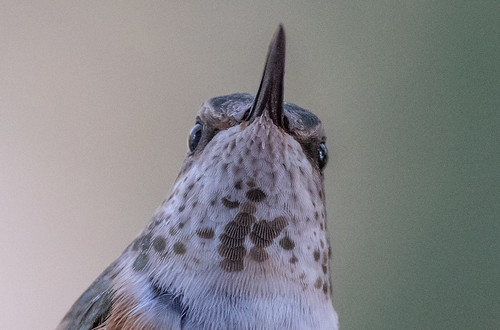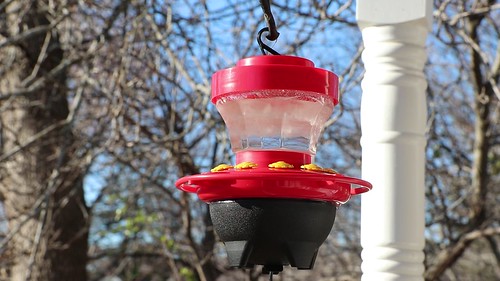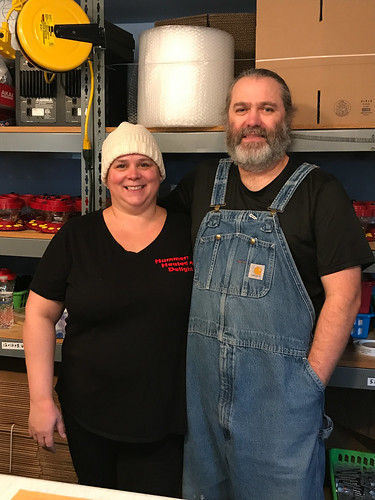Thanksgiving morning began with a temperature of 11º F on my front porch, but surreal as it may be, at 7:16, nine minutes before sunrise, the little Rufous Hummingbird appeared at my window. I’d brought my two normal feeders in overnight, setting them out just before 7 so the water wasn’t too terribly cold yet, but ice crystals were forming by 7:45, so I swapped them out with feeders from inside—something I had to do every half hour to forty-five minutes all day. The temperature didn’t rise much—at mid-afternoon, it had barely crept up to 19. After being distracted for an hour making dinner rolls, I looked out to see the hummer sitting at the side-yard feeder, the sugar water and ice crystals forming a thick slurry. Fortunately, it wasn’t the kind of ice her tongue could stick to, but of course that made me wonder whether a hummingbird tongue could stick to ice. The answer will remain a mystery forever.
On Thanksgiving night when I hit the sack, the temperature was 10º, but when I got up at 6:50 the next morning, it was already 19º and expected to be rising to slightly above freezing by afternoon, making Friday much easier than Thursday was.
Keeping hummingbird feeders thawed on a day like that reminded me of the only other time we had a hummingbird in the yard on a Thanksgiving, in 2004. Oddly enough, we were spending that holiday with our son Joey in Florida, so I didn’t have to do any of the work of swapping out feeders for several frozen days. My sweet mother-in-law, who was 85 at the time, was staying at our house while we were gone. The original plan called for her to feed our two dogs, two cats, and my education owl, Archimedes, but she took the additional hummingbird responsibilities right in stride. I’d have felt worse about it except she enjoyed bragging rights, boasting to her friends about both the owl and the November hummingbird she was taking care of.
But she was apparently a lot hardier than I am. Just this Tuesday, I learned about a simpler way to keep sugar water thawed. When I described the logistics of swapping out hummingbird feeders all day on Facebook’s Duluth Nature Notes, one of the participants, Susan Darley-Hill, commented: “Our daughter in Washington has Anna’s hummers year-round (well below freezing many evenings); we ordered them a heated feeder and it was shipped to them from…Two Harbors. A small family-owned biz.”
She provided a link to an amazing local resource I’d never heard of, “Hummers Heated Delight” (hummersheateddelight.com). I was intrigued, read their website, and sent an email. I heard back the next morning and as soon as I could, I headed out to Two Harbors.
Hokey smoke—this was exactly what I needed! The market for heated hummingbird feeders is definitely a niche one, but Dave and Carrie Bolen are doing an amazing job of providing just what people in my situation need. The company was started in 2012 by Dave Bolen's uncle Lars Bolen in Oregon, where a lot of people need heated hummingbird feeders for the Anna's Hummingbirds that now winter there and even further north. That range expansion was not due to feeders but to climate change and changes in vegetation, especially hummingbird gardens and ornamental trees.
Lars and his wife Sharon got the company off the ground, but he died in 2014, and she in 2017. The next year, Dave and Carrie took over production and management of Hummers Heated Delight to ensure their legacy. On their website, they say, "We intend to show the company, feeders and customers the same kind of attention and detail our Uncle and Aunt always did." Based on my experience, Dave and Carrie are more than living up to that legacy.
David Bolen and his mother were the ones there when I got there, and were both wonderfully nice, and the feeder is perfect. I set it up as soon as I got home, when it was still bright outside. Within an hour or so of setting it up, the hummingbird was already feeding at it. If I hadn’t known that the heating mechanism is simply a 7-watt lightbulb, I’d never have guessed until after the sun went down, when the feeder started glowing.
On Thanksgiving morning, when it was so cold, there was ice at the top of the clear tank of the feeder, but the water lower down and in the feeding reservoir stayed thawed through that frigid night.
That evening I got an email from the Bolens telling me they’d just remembered that they send a 15-watt bulb to customers in Alaska, and that might be a better choice here in Duluth, too. They would have shipped it to me for free, but I figured if this hummingbird stays around much longer, I could use a second heated feeder anyway so I wouldn’t have to go outdoors to swap feeders anymore. The third one, right in my home office window, is easy to swap out no matter how cold it is. Also, I thought it would be worthwhile to compare two identical feeders with different bulbs to see how often the higher wattage is a better choice. The original 7-watt bulb uses half the energy and keeps the water a little closer to air temperature like natural food would be, but I'm sure the 15-watt bulb keeps the sugar water thawed at more extreme temperatures.
So I headed out on a second shopping venture to Hummers Heated Delight on, of all days, Black Friday. This visit was even funner than the first one, because I got to meet Carrie Bolen, and now I have bragging rights. I will always have the distinction of being their very first Black Friday in-shop customer!
I hadn’t even thought about the possibility of a heated hummingbird feeder since 2004, but now that I have two, whether my Rufous Hummingbird moves on quickly or not, I’ll have the feeders handy to use whenever we have unseasonable cold snaps in May. Or maybe in another 17 years another November hummingbird will show up again. Hope really is the thing with feathers. Little tiny hummingbird feathers.









